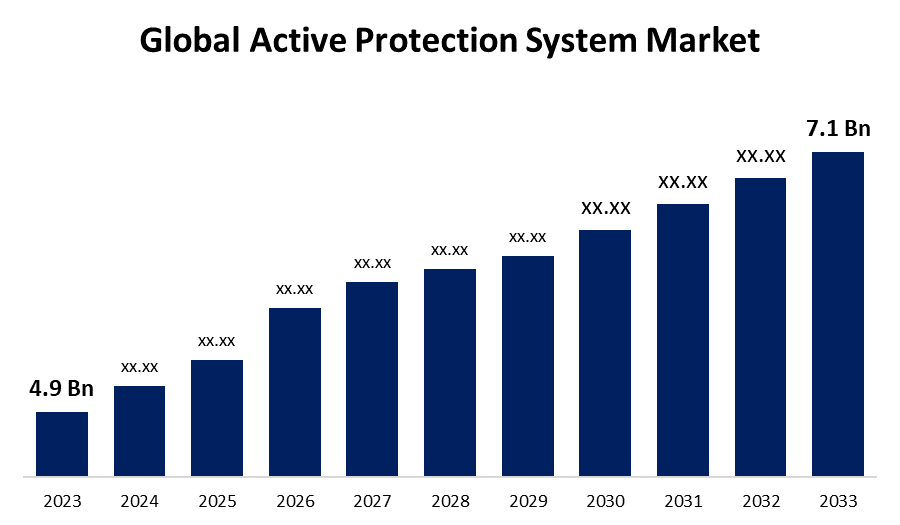Global Active Protection System Market Size, Share, and COVID-19 Impact Analysis, By Platform (Ground, Airborne, Marine); By Kill System (Soft Kill System, Hard Kill System, Reactive Armor; By End-Use (Defense, Homeland Security), and By Region (North America, Europe, Asia-Pacific, Latin America, Middle East, and Africa), Analysis and Forecast 2023 - 2033
Industry: Aerospace & DefenseGlobal Active Protection System Market Insights Forecasts to 2033
- The Active Protection System Market Size was valued at USD 4.9 Billion in 2023.
- The Market Size is growing at a CAGR of 3.78% from 2023 to 2033.
- The worldwide Active Protection System Market is expected to reach USD 7.1 Billion by 2033.
- Asia Pacific is expected to grow the fastest during the forecast period.

Get more details on this report -
The Global Active Protection System Market Size is expected to reach USD 7.1 Billion by 2033, at a CAGR of 3.78% during the forecast period 2023 to 2033.
The Active Protection System (APS) market is experiencing significant growth, driven by the increasing demand for advanced defense technologies in military and defense sectors. APS aims to protect armored vehicles, aircraft, and naval vessels from missile and projectile threats by detecting and neutralizing them in real time. With rising geopolitical tensions and the modernization of defense forces globally, the need for robust defense mechanisms has spurred market expansion. Technological advancements, such as the integration of radar, infrared sensors, and countermeasure technologies, are further enhancing APS capabilities. Key players in the market include companies developing cutting-edge systems that provide active counteractions, leading to a shift in defense strategies from passive armor solutions to more dynamic, responsive protection systems. The Active Protection System market is expected to continue evolving, with increasing defense budgets globally.
Active Protection System Market Value Chain Analysis
The Active Protection System market value chain consists of several key stages, starting with research and development (RandD) of innovative technologies. Companies invest heavily in developing advanced sensors, radars, and countermeasure systems to detect and neutralize threats. The next stage involves component manufacturing, where suppliers produce critical hardware such as interceptor systems, sensors, and control units. These components are then integrated into platforms like military vehicles, aircraft, and naval ships. The integration process is followed by testing and deployment, ensuring systems meet defense specifications. After installation, ongoing support and maintenance are crucial, ensuring operational efficiency. Lastly, end-users, including defense ministries and contractors, drive demand and influence purchasing decisions. The entire value chain is marked by strong collaboration between manufacturers, technology developers, and defense agencies.
Active Protection System Market Opportunity Analysis
The Active Protection System market offers significant opportunities driven by the growing need for advanced defense solutions. As geopolitical tensions rise, governments are increasingly investing in modernizing their defense fleets, creating demand for next-generation protection systems. The integration of APS into ground vehicles, aircraft, and naval vessels presents lucrative opportunities for market growth. Furthermore, the adoption of AI and machine learning in APS technologies enhances their accuracy and speed, providing a competitive edge. The rise in asymmetric warfare and the increasing threat from anti-tank guided missiles (ATGMs) also drive the market. Additionally, emerging economies and defense modernization programs in countries like India, China, and Russia are opening new markets. Partnerships between defense contractors and technology firms offer further growth potential in this sector.
Global Active Protection System Market Report Coverage
| Report Coverage | Details |
|---|---|
| Base Year: | 2023 |
| Market Size in 2023: | USD 4.9 Billion |
| Forecast Period: | 2023 – 2033 |
| Forecast Period CAGR 2023 – 2033 : | 3.78% |
| 023 – 2033 Value Projection: | USD 7.1 Billion |
| Historical Data for: | 2019-2022 |
| No. of Pages: | 225 |
| Tables, Charts & Figures: | 122 |
| Segments covered: | By Platform, By Kill System, By End-Use and By Region |
| Companies covered:: | Airbus Group Artis LLC Aselsan A.S. IMI Systems Ltd Israel Military Industries JSC RPC KBM Krauss Maffei Wegmann LLC Rafael Advanced Defense Systems Raytheon Company Rheinmetall AG Saab AB Safran Electronics & Defense |
| Pitfalls & Challenges: | COVID-19 Empact,Challenges, Future, Growth, & Analysis |
Get more details on this report -
Market Dynamics
Active Protection System Market Dynamics
The increasing geopolitical instability and the expanding role of automation in the defense sector
The increasing geopolitical instability and the expanding role of automation in the defense sector are key factors driving the growth of the Active Protection System (APS) market. As global tensions rise, governments are prioritizing advanced defense technologies to enhance national security, leading to higher investments in APS. The need for more efficient and effective protection systems has amplified as threats such as guided missiles and projectiles become more sophisticated. Additionally, the growing integration of automation, artificial intelligence, and machine learning in defense applications is improving the performance and adaptability of APS. These advancements enable systems to detect, track, and neutralize threats faster and with greater accuracy. As a result, the Active Protection System market is experiencing accelerated growth, with defense organizations seeking cutting-edge solutions to safeguard critical assets.
Restraints and Challenges
One of the primary obstacles is the high cost of development, integration, and maintenance of advanced APS technologies, which can be prohibitive for some defense budgets. Additionally, the complexity of integrating APS with existing military platforms, such as armored vehicles and aircraft, poses technical challenges, requiring significant time and expertise. The evolving nature of threats also demands constant innovation, which can strain resources and research efforts. Another challenge is the regulatory and operational environment, with concerns over the reliability and legal implications of deploying automated defense systems in conflict zones. Finally, the potential for countermeasures and anti-APS technologies from adversaries could limit the effectiveness of these systems, complicating defense strategies.
Regional Forecasts
North America Market Statistics

Get more details on this report -
North America is anticipated to dominate the Active Protection System Market from 2023 to 2033. The U.S. Department of Defense has been at the forefront of integrating APS into its military platforms, such as armored vehicles, tanks, and aircraft, to enhance protection against modern threats like guided missiles and RPGs. With a focus on technological innovation, North American companies are developing cutting-edge APS solutions, incorporating artificial intelligence, machine learning, and advanced sensors for improved threat detection and neutralization. Additionally, increasing defense budgets and a growing emphasis on modernization within the U.S. and Canadian armed forces are fueling market growth. Collaboration between defense contractors, government agencies, and technology developers further strengthens North America's position in the Active Protection System market.
Asia Pacific Market Statistics
Asia Pacific is witnessing the fastest market growth between 2023 to 2033. China, India, and Japan are heavily investing in modernizing their military fleets and upgrading armored vehicles, tanks, and naval vessels, creating a significant demand for Active Protection System. The region’s strategic concerns, including territorial disputes and evolving security threats, have made APS a priority in defense strategies. Furthermore, the adoption of cutting-edge technologies such as AI, machine learning, and advanced sensors is enhancing the performance of Active Protection System in detecting and neutralizing incoming threats. Collaborative efforts between regional defense agencies and technology developers, alongside the expansion of defense budgets, are positioning the Asia Pacific as a key player in the global Active Protection System market.
Segmentation Analysis
Insights by Platform
The ground segment accounted for the largest market share over the forecast period 2023 to 2033. As modern warfare evolves, the threat from anti-tank guided missiles (ATGMs) and improvised explosive devices (IEDs) has led to a stronger focus on APS integration into ground vehicles. Countries are investing in advanced APS solutions to safeguard military personnel and critical assets. The adoption of AI, radar, and sensor technologies is improving the efficiency and speed of threat detection and interception, making ground vehicles more resilient on the battlefield. Additionally, with the growing demand for military modernization in regions such as North America, Asia, and Europe, the ground segment is expected to continue its rapid growth, reflecting the increasing priority placed on defensive systems.
Insights by Kill System
The soft kill segment accounted for the largest market share over the forecast period 2023 to 2033. Soft kill systems aim to disrupt or confuse incoming threats, such as missiles and projectiles, by using electronic jamming, spoofing, or decoys. These systems are becoming increasingly popular as a cost-effective solution to complement hard kill systems, which physically intercept threats. The growing complexity of modern warfare and the need for multi-layered defense mechanisms are fueling the demand for soft kill solutions. As military platforms, including ground vehicles, aircraft, and naval vessels, continue to integrate more sophisticated soft kill technologies, their ability to neutralize a wider range of threats is improving. This trend is particularly prominent in regions investing heavily in defense, such as North America, Europe, and Asia.
Insights by End Use
The defence segment accounted for the largest market share over the forecast period 2023 to 2033. Armed forces globally are prioritizing APS to enhance the protection of their assets, including tanks, armored vehicles, aircraft, and naval vessels, from modern threats such as guided missiles, rockets, and projectiles. As geopolitical tensions escalate, defense budgets are rising, with many nations investing in APS to improve their defensive capabilities. Technological advancements in sensors, radar systems, and countermeasure technologies are contributing to the effectiveness and adoption of APS solutions in military operations. The shift towards more dynamic, responsive defense systems combining both hard and soft kill technologies has further accelerated the growth of the defense segment. This trend is particularly strong in North America, Europe, and parts of Asia Pacific.
Recent Market Developments
- In October 2022, Raytheon Missiles and Defense collaborated with Lockheed Martin to develop the Javelin, a versatile missile system that can be launched from both the shoulder and various platforms, offering a fire-and-forget capability with a range of over 4 kilometers.
Competitive Landscape
Major players in the market
- Airbus Group
- Artis LLC
- Aselsan A.S.
- IMI Systems Ltd
- Israel Military Industries
- JSC RPC KBM
- Krauss Maffei Wegmann LLC
- Rafael Advanced Defense Systems
- Raytheon Company
- Rheinmetall AG
- Saab AB
- Safran Electronics and Defense
Market Segmentation
This study forecasts revenue at global, regional, and country levels from 2023 to 2033.
Active Protection System Market, Platform Analysis
- Ground
- Airborne
- Marine
Active Protection System Market, Kill System Analysis
- Soft Kill System
- Hard Kill System
- Reactive Armor
Active Protection System Market, End Use Analysis
- Defense
- Homeland Security
Active Protection System Market, Regional Analysis
- North America
- US
- Canada
- Mexico
- Europe
- Germany
- Uk
- France
- Italy
- Spain
- Russia
- Rest of Europe
- Asia Pacific
- China
- Japan
- India
- South Korea
- Australia
- Rest of Asia Pacific
- South America
- Brazil
- Argentina
- Rest of South America
- Middle East and Africa
- UAE
- Saudi Arabia
- Qatar
- South Africa
- Rest of the Middle East and Africa
Frequently Asked Questions (FAQ)
-
1. What is the market size of the Active Protection System Market?The global Active Protection System Market is expected to grow from USD 4.9 billion in 2023 to USD 7.1 billion by 2033, at a CAGR of 3.78% during the forecast period 2023-2033.
-
2. Who are the key market players of the Active Protection System Market?Some of the key market players of the market are Airbus Group, Artis LLC, Aselsan A.S., IMI Systems Ltd, Israel Military Industries, JSC RPC KBM, Krauss Maffei Wegmann LLC, Rafael Advanced Defense Systems, Raytheon Company, Rheinmetall AG, Saab AB, Safran Electronics and Defense.
-
3. Which segment holds the largest market share?The defence segment holds the largest market share and is going to continue its dominance.
Need help to buy this report?